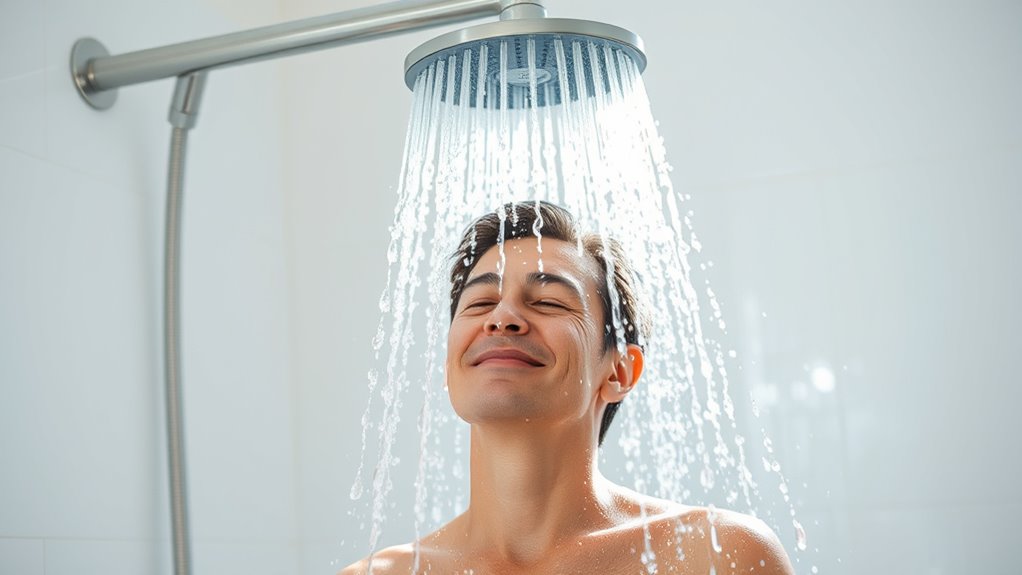Taking cold showers can markedly boost your circulation by causing your blood vessels to constrict and then quickly dilate, which improves blood flow and strengthens your cardiovascular system. This process helps deliver oxygen and nutrients more efficiently, reduces inflammation, and supports overall vascular health. Over time, your blood vessels become more flexible and resilient, lowering your risk of blockages and high blood pressure. Keep exploring to discover how cold exposure can further enhance your circulatory health.
Key Takeaways
- Cold showers cause vasoconstriction followed by dilation, improving overall blood flow and circulation.
- They activate the sympathetic nervous system, increasing heart rate and promoting cardiovascular health.
- Cold exposure reduces inflammation and enhances circulation to remove metabolic waste.
- Regular cold showers boost oxygen and nutrient delivery, increasing mental alertness and physical energy.
- Long-term use strengthens blood vessels, supporting healthy blood pressure and reducing cardiovascular risks.

Taking cold showers might seem uncomfortable at first, but they offer a surprising boost to your circulation. When you expose your body to cold water, you’re engaging in a form of ice therapy that activates your body’s natural responses. This sudden temperature change causes your blood vessels to constrict, a process known as vasoconstriction. While it might sound counterintuitive, this constriction actually stimulates your blood flow once you exit the cold water. As your body works to warm itself, your blood vessels dilate again, improving overall blood circulation. This cycle of constriction and dilation enhances blood flow throughout your body, delivering oxygen and nutrients more efficiently to your tissues. Regular exposure to cold water can also help strengthen your cardiovascular system by encouraging your blood vessels to remain resilient and adaptable.
Cold showers trigger your body’s sympathetic nervous system, often called the fight-or-flight response. This activation increases your heart rate and promotes better circulation, which can help reduce the risk of blood stagnation and improve vascular health. The invigorating effect of cold water makes your blood vessels more flexible over time, reducing the risk of blockages and supporting healthy blood pressure levels. Vascular health is crucial for overall wellness, and cold showers can contribute positively to this aspect.
There’s also an aspect of ice therapy involved in cold showers that contributes to circulation benefits. Ice therapy is commonly used by athletes to reduce inflammation and promote healing, but it also stimulates blood flow in a similar way. When cold water hits your body, your body responds by increasing circulation to maintain core temperature. This increased blood flow helps remove metabolic waste and delivers fresh oxygen-rich blood to tissues, which can speed up recovery and reduce soreness. Over time, this process can improve your body’s ability to respond to physical stress and enhance overall cardiovascular efficiency.
You might notice that after a cold shower, you’re more alert and energized. This is partly because improved circulation delivers oxygen and nutrients to your brain and muscles more rapidly, boosting your mental clarity and physical readiness. Consistent cold exposure trains your blood vessels to react more effectively, leading to improved circulation even outside of shower time. As your vascular system adapts, you’ll likely experience better endurance, quicker recovery from exertion, and a general sense of vitality.
Incorporating cold showers into your routine can be a simple yet powerful way to support your circulatory health. By leveraging ice therapy principles, you stimulate blood flow, strengthen your blood vessels, and promote better overall cardiovascular function. While initially challenging, the long-term benefits make cold showers a valuable addition to your health regimen.
Frequently Asked Questions
How Long Should I Take a Cold Shower for Circulation Benefits?
You should aim for a cold shower duration of about 2 to 5 minutes to maximize circulation benefits. Start with shorter periods and gradually increase as your body adapts. For ideal results, incorporate cold showers into your routine 3 to 4 times a week. Following these duration guidelines and maintaining consistent cold shower frequency helps boost blood flow and overall cardiovascular health effectively.
Can Cold Showers Help With Chronic Circulation Issues?
You might find cold showers helpful for chronic circulation issues. For example, frequent cold exposure causes vasoconstriction, which constricts blood vessels, but then triggers vasodilation afterward, improving blood flow. This process can help enhance circulation over time, especially if integrated into your routine. While not a cure, cold showers may support your vascular health by promoting better blood vessel function and reducing symptoms associated with poor circulation.
Are There Any Risks Associated With Cold Showers for Circulation?
Yes, cold showers can pose risks involved, especially if you have circulatory issues. Sudden exposure to cold water might trigger circulatory shock in some individuals, causing a rapid increase in blood pressure or fainting. If you have existing heart or circulation problems, it’s best to consult your doctor before trying cold showers. Always start gradually to minimize risks involved and monitor how your body responds.
How Often Should I Take Cold Showers to See Results?
You should aim for cold showers at least three to four times a week to see noticeable results. Stick to a consistent schedule, such as every other day, to help your body adapt and optimize circulation benefits. Keep in mind that gradual exposure is key; start with warm water and slowly incorporate cold water at the end. Consistency helps your body respond better over time.
Do Cold Showers Benefit Specific Age Groups Differently?
You might think cold showers benefit everyone equally, but age-specific responses do vary. Younger individuals often experience faster circulation boosts with shorter cold shower durations, while older adults may need gradual exposure to avoid shock. it is crucial to tailor cold shower duration carefully based on your age, listening to your body’s signals. Starting with brief cold showers and increasing gradually helps optimize benefits across different age groups.
Conclusion
So, next time you hop into a cold shower, remember it’s more than just a invigorating shock. That sudden burst of cold might be coincidentally boosting your circulation just when you need it most. It’s like nature’s little secret, quietly working behind the scenes to energize your body. Embrace the chill, and you might find those circulation benefits surprise you in the most unexpected ways. Sometimes, the smallest changes make the biggest difference.









